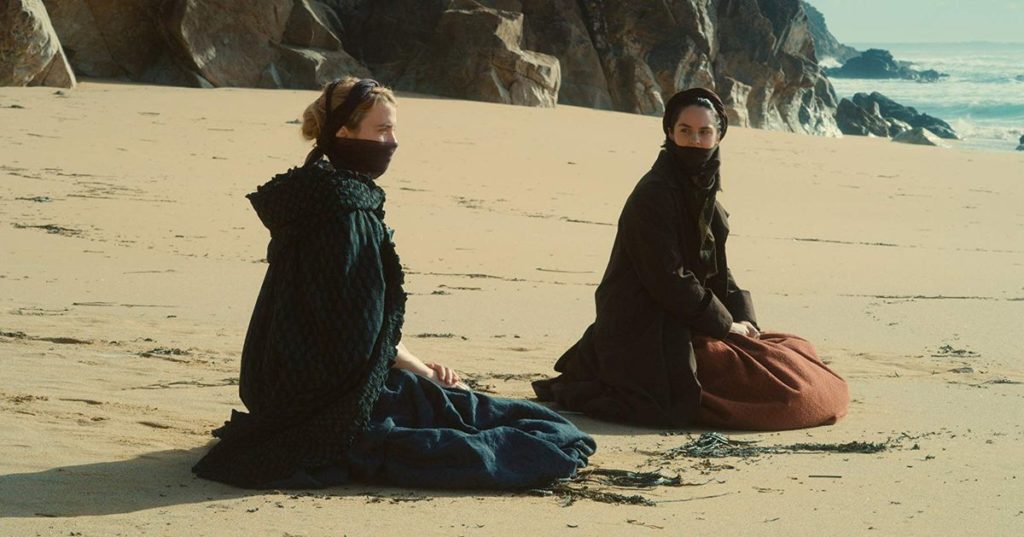
Portrait of a Lady on Fire explores an unexpected and forbidden romance between two women in the late 18th century. Set on the lush and grainy beaches of an island in France, this heartbreaking love story reveals the thousands of tiny deaths queer women have endured for sake of patriarchal tradition.
The film is simple yet refined in its telling of the commonplace oppressions of women historically and to this day. It also proves that queer love has no defining time nor presence in the world: We have always been here. And we have always had to sacrifice some semblance of ourselves in order to make other people comfortable or to appease antiquated and bigoted social systems. Portrait of A Lady on Fire is bittersweet in its remembrance and reminder of how some things have remained the same.
In the film industry, women are still only just finding footing and visibility behind the camera, particularly in mainstream film. Notably, Portrait of a Lady on Fire has heralded the success of female filmmakers and cinematographers, winning the Queer Palm at Cannes, a first for director Céline Sciamma and the first Queer Palm for a woman director in the history of Cannes. Famed French cinematographer Claire Mathon won the Los Angeles Critics Association Award, The Lumiéres Award, and Cèsar Award for Best Cinematography. Their real-world wins as women and for Sciamma as a lesbian paired with the intimate and irrefutably queer content of the film demonstrate that dynamics are shifting in the field. We can only hope that the momentum continues to open every door to female creatives—and more queer stories to grace our screens.
Portrait of a Lady on Fire itself plays out like a painting, soft and brash, mysterious and all knowing—subtle contradictions that mirror the lives of two young women who find each other in a world full of emotional complexities. Interestingly, the film is not only about lesbian love, but also about the magic of femininity and its subtle resistance in a world where the feminine and the emotional is subordinated. The film also holds a proverbial mirror up to women forced to maintain systems in order to retain their status and “normalcy,” no matter the cost.
Spoiler alert: Major spoilers for Portrait of a Lady on Fire follow. If you haven’t seen the film and don’t want to be spoiled, bookmark this page and return after you’ve watched it.

Marianne (Noémie Merlant) is a painter that arrives on the peninsula for a commission. Upon arrival, she is informed that she will be painting an aristocrat named Héloïse (Adèle Haenel) who has been promised to a Milanese nobleman. Having previously lived in a convent, Héloïse abhors her looming gilded cage, passed down to her by her older sister, who died by suicide. Her reluctance to go willingly into her fate prompted her mother to commission a portrait of her daughter in her wedding dress.
Forced to keep her identity as a painter a secret so as not to upset Héloïse, Marianne must paint Héloïse from memory. Her “official” role is to keep Héloïse company and make sure that she doesn’t throw herself off a cliff like her sister did before her. There is a certain freedom within death that rings true as Héloïse flirts with a solution to her betrothal. Through Marianne, she senses the freedom that she could never achieve, due to her status as an aristocrat. It’s not that we are made to feel sorry for a rich woman, but to feel sad for the lack of choices the patriarchy offers women. When Héloïse’s mother leaves for five days, the two women get a taste of the freedom that they have longed for: a freedom that allows them to embrace their identities and realize how different their paths in life are.
Marianne is able to live life on her terms because of her ability to paint and having inherited her father’s business. Héloïse, trapped in the small life of an aristocrat’s wife, could have been envious of Marianne’s freedom but instead, she falls in love. As the two become closer, Marianne reveals both that she was hired to paint Héloïse and that she’s unable to do so.
Marianne failing to paint a picture of Héloïse without knowing her speaks volumes. As a painter, Marianne has been conditioned to paint people as they look, not as who they are. She knows that Héloïse’s true self cannot be captured for such a soulless task of being showcased to a man she doesn’t know. It’s likely that she didn’t want to have her image immortalized for that very reason. Only after the love between herself and Marianne begins to blossom does she consent to be painted—their love proves that it takes more to understand another soul than just an image.
In their unsupervised time, Héloïse and Marianne experiment with drugs, wander the island endlessly, and steal kisses in between discoveries. They meet a society of women who gather in the woods to sing and trade health information and spells. It is everything that Héloïse could only dream of, having only been prepared for a life of domesticity and motherhood. Discussions of abortion, rape, and internalized misogyny play out in a poetic symphony as the women live out a lifetime of love and community in five days.
Ultimately, Marianne must leave Héloïse and the island to return to her own life and business, while Héloïse must marry the man her family chose for her. Though that reality is tragic, there is also hope there. Marianne will always carry with her the portrait she made of the woman she loved, the lady on fire.
Much to my surprise, as a Black, bisexual woman I found myself in Marianne and Héloïse. I saw my own experiences reflected in their innocent gazes, the thrill they feel at finding someone who understands who they are, and the rush of a first love in a world where it cannot be described. I am far removed from an aristocratic life, but I do understand the pressures families can hold on women who are headed for (queer) destruction. To be able to refuse to participate in compulsory heterosexual relationships because it is expected is brave and a privilege that would not have been possible during Marianne and Héloïse’s lifetimes.
Though the film takes place centuries ago, it is shockingly relevant to today, revealing that for as far as we have come, we have so much further yet to go. Women’s equality has progressed at a snail’s pace and the social pressures to marry a man and have children have not disappeared alongside dated dresses. Portrait of a Lady on Fire makes it apparent the need for women’s and queer people’s liberation.
 Monika Estrella Negra (she/her) is a freelance journalist, filmmaker and curator of all things radical in media. Her first short titled “Flesh” was included in the ‘Horror Noire’ syllabus. She has directed three additional shorts, ‘They Will Know You By Your Fruit’, ‘Succubus’, and the in production ‘Bitten, A Tragedy’. Monika has written essays for Syfy Fangrrls, Black Girl Nerds, Grimm Magazine, and more. In addition, she is the creator of Audre’s Revenge Film and Black and Brown Punk Show Chicago, a GRRL Haus Cinema Resident Filmmaker (2019) and editor of DecodedPride.com. Learn more about Monika on her Authory site.
Monika Estrella Negra (she/her) is a freelance journalist, filmmaker and curator of all things radical in media. Her first short titled “Flesh” was included in the ‘Horror Noire’ syllabus. She has directed three additional shorts, ‘They Will Know You By Your Fruit’, ‘Succubus’, and the in production ‘Bitten, A Tragedy’. Monika has written essays for Syfy Fangrrls, Black Girl Nerds, Grimm Magazine, and more. In addition, she is the creator of Audre’s Revenge Film and Black and Brown Punk Show Chicago, a GRRL Haus Cinema Resident Filmmaker (2019) and editor of DecodedPride.com. Learn more about Monika on her Authory site.





